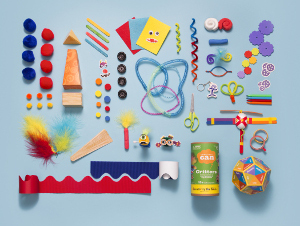LENS Innovate
Building Without Boundaries
An Alumna's Crusade to Cultivate Young Creative Minds
 PHOTO: Bill Sallans
PHOTO: Bill SallansPhyllis Brody co-developed creativity kits—that include supplies such as these—to give children the freedom to create without instructions.
As parent volunteers at a Cleveland Heights elementary school in the mid-1970s, Phyllis Brody (SAS ’58) and another mother would often bring in simple art kits—paper, popsicle sticks, pipe cleaners—and watch as the students started creating, without instruction or direction. “Something magical would happen with the children,” Brody said.
Brody and her friend, Evelyn Greenwald, decided to turn those kits into a business. Working out of Brody’s basement and Greenwald’s dining room, they gathered materials and supplies and packed them in burlap sacks.
They named their nascent brand Creativity for Kids and quickly realized that their mission—to give children open-ended opportunities to pursue their own ideas—made them pioneers.
And in 1986 when Playthings magazine created a new toy category, “creative activities,” in its annual directory, “we were the only one listed,” Brody said. That listing (under the original name of Creative Art Activities Inc.) can be seen in magazine archives housed at The Strong National Museum of Play in Rochester, New York.
Little by little, the business found customers, and as it grew, Brody employed lessons from Case Western Reserve, where she earned a master’s degree in psychiatric social work. “Understanding how children develop through play certainly influenced our product development,” said Brody, who also met her late husband, Ralph Brody, PhD (ADL ’56; SAS ’58, ’74) on the first day of graduate school.
The company eventually replaced the burlap with more colorful packaging and swelled its product offerings. German art supply giant Faber-Castell acquired the company in 1999 and made Cleveland its U.S. headquarters.
Through the years, hundreds of Creativity for Kids products have been developed, including everything from puppet-making projects to kits that help teach kids the process of invention.
Brody stayed on full-time for a decade. Her current part-time role is dedicated to a newer line: the Creativity Can. Brody said the cans—there are six types all with art supplies and open-ended options—recently were tested in a local elementary school and inspired children’s creativity, communication, collaboration and problem-solving skills. “Children learn from challenges that engage them in problem solving,” she said. “Seeing the way they play with the Creative Cans was just a very, very powerful reaffirmation.”





